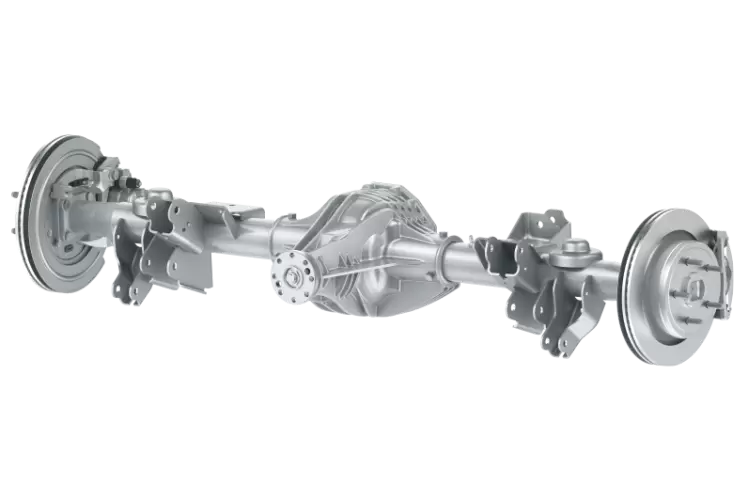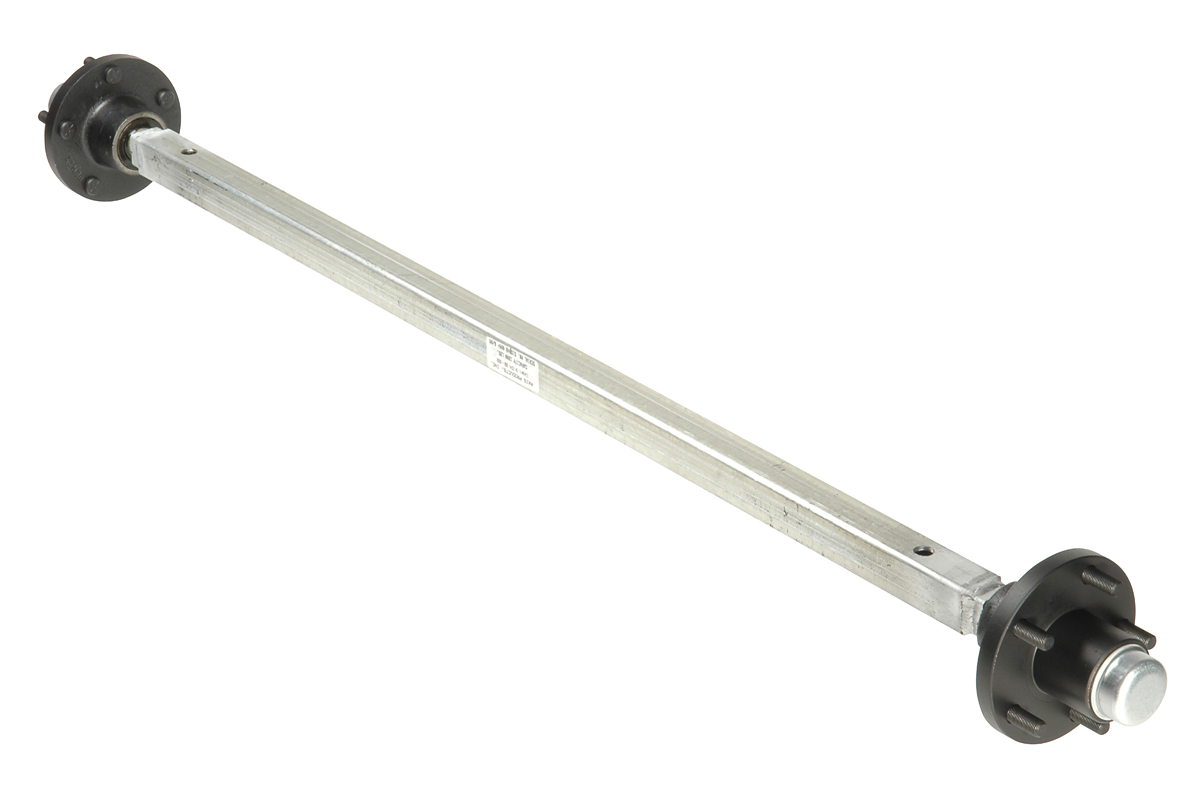Product Description
Product Description
trailer axle Features
1). Special heat-treated, low-alloy steel axle beam, offers more stability, greater capacity and lighter weight.
2). Forged camshafts with hardened wear surface for the axle
3). Solid inserted spindle and bearing journals laser heat treated, provide superior fatigue capability.
4). High performance premium non-asbestos brake linings, extend service life.
5). Easy for ABS installation.
Trailer axle specification:
| Model | Max.capacity(T) | Track(mm) | Brake(mm) | Axle beam | P.C.D(mm) | Total length(mm) |
| CZZDW-10.5 | 10.5 | 1820 | 420×180 | φ127 | 285.75 | 2165 |
| CZZDW-13 | 13 | 1840 | 420×180 | 150×150 | 285.75 | 2185 |
| CZZDW-15 | 15 | 1850 | 420×180 | 150×150 | 335 | 2185 |
| CZZDW-16 | 16 | 1850 | 420×220 | 150×150 | 335 | 2185 |
| CZZDW-14 | 14 | 1840 | 420×200 | 150×150 | 281 | 2175 |
note:
1. Material : Steel
2. Drum, Brake CZPT 420x180mm, Track TR 1840mm
3.Axle Beam you can choose:150*150,127*127,Φ127
4. product type:American,Germany and Europe type
5.Max.capacity you can choose:12T,13T,14T,15T,16T
6.Stud:10*M20*1.5
Detailed Photos
Company Profile
Xihu (West Lake) Dis. Changzai Machinery Manufacturing Co., Ltd is 1 of the major manufacturers specializing in the production of semi-trailer parts, including Axles, Suspension assemblies, Leaf springs, Landing gears, King pins, Fifth wheels, Air brake chambers, Air tanks, Twist locks and so on. We can provide high quality products with competitive price and good services.
Other sales products
Our service
1. Q:What’s your best price for this product?
A: We are manufacturer and will quote you best price according to your quantity, so when you making an inquiry, please let us know the quantity you want.The more quantity the better price.
2. Q:How about the quality of this product?
A: Our products are certified to ISO9001, TS16949 international quality standards. We compay have very strict Quality Control Systems.
3. Q:What material of the product can you supply?
A: Steel
4. Q:What’s your MOQ?
A: 10pcs for each model. We hope you can buy more to save more money.
5. Q:What’s the delivery time?
A: For products that are in stock, we can ship it within 7 days after receiving your payment. For custom order, quantity within 24 tons, production time is 12-20 days after confirmed every details.
6. Q:What’s your packing?
A:Our usual packing for this product is pallet, we can also supply you packing according to your requirements.
7. Q:Can we custom our own logo or label on this product?
A: Yes, you can. we support logo print & stamping & label print, print will be free if the logo is not very complex.
8. Q:What about the warranty?
A: We are very confident in our products, and we pack them very well to make sure the goods in well protection.
To avoid any subsequent trouble regarding quality issue, we suggest that you check the springs once you receive them. If there is any transport damaged or quality issue, don’t forget take the detail pictrues and contact us as soon as possible,we will properly handle it, make sure your loss to reduce to the smallest .
Our exhibition
| After-sales Service: | Yes |
|---|---|
| Condition: | New |
| Axle Number: | 2 |
| Application: | Trailer |
| Certification: | ISO |
| Material: | Iron |
| Customization: |
Available
| Customized Request |
|---|

How does a solid beam axle impact the ride quality of a vehicle?
A solid beam axle can have both positive and negative impacts on the ride quality of a vehicle. The specific effects depend on various factors, including the suspension setup, road conditions, and the vehicle’s intended use. Here’s how a solid beam axle influences ride quality:
1. Simplicity and Durability:
Positively, solid beam axles are known for their simplicity and durability. The absence of complex moving parts makes them robust and less prone to mechanical failures. This can contribute to a smoother ride over time, as there are fewer components to wear out or require maintenance.
2. Load Distribution:
A solid beam axle’s design allows for even distribution of weight across both wheels on the axle. This can lead to improved stability and handling, especially when carrying heavy loads. Vehicles with solid beam axles may have reduced body roll, enhancing the perception of ride quality.
3. Off-Road Capability:
Solid beam axles are commonly used in off-road vehicles due to their ability to maintain wheel contact with uneven terrain. In off-road applications, this feature can lead to a more comfortable ride, as the suspension flexes to absorb shocks and maintain traction on challenging surfaces.
4. Stiffness and Comfort:
On the downside, solid beam axles are generally stiffer compared to independent suspension systems. This stiffness can result in a less comfortable ride on smooth or well-paved roads. The vehicle may transmit more road imperfections and vibrations to the passengers.
5. Limited Articulation:
In certain situations, a solid beam axle’s limited articulation can impact ride quality. For example, when one wheel encounters a bump or obstacle, the other wheel is affected as well. This can lead to a bumpier ride compared to independent suspension systems, where each wheel can move independently to absorb shocks.
6. Road Conditions:
Ride quality is highly dependent on road conditions. On rough, uneven, or unpaved roads, a solid beam axle may perform better by maintaining wheel contact and stability. Conversely, on smooth and well-maintained roads, the ride quality may be less comfortable due to the stiffness of the axle.
7. Vehicle Design and Tuning:
Manufacturers can influence ride quality by designing the suspension components and tuning the shock absorbers to complement the solid beam axle. While the inherent stiffness remains, adjustments can be made to mitigate the negative effects and enhance comfort.
8. Passenger Expectations:
Ultimately, perceptions of ride quality can vary among passengers. Some may prioritize stability and load-carrying capacity, accepting the trade-off of a stiffer ride. Others may prioritize a smoother, more comfortable ride and opt for vehicles with independent suspension systems.
Summary:
The impact of a solid beam axle on ride quality is influenced by various factors, including the vehicle’s design, suspension tuning, and road conditions. While solid beam axles offer durability, load distribution, and off-road capability, they may result in a stiffer and less comfortable ride on smooth roads when compared to independent suspension systems.

What is the history of beam axles in automotive engineering?
The history of beam axles in automotive engineering is rich and spans several decades. Beam axles, also known as solid axles or live axles, have played a crucial role in the development of vehicles. Here’s a brief overview of their history:
Early Automobiles:
When automobiles were first introduced in the late 19th and early 20th centuries, they primarily used beam axles due to their simplicity and reliability. These axles provided a solid platform for mounting the wheels and supporting the vehicle’s weight. Early cars often featured front and rear beam axles connected by leaf springs for a smoother ride.
1920s and 1930s:
During the 1920s and 1930s, beam axles were prevalent in the automotive industry. They were commonly found in both passenger cars and commercial vehicles. The Ford Model T, for example, used beam axles and was one of the most iconic vehicles of that era.
Evolution and Diversification:
As automotive engineering progressed, there was a diversification of suspension systems. While beam axles remained a staple in many vehicles, independent suspension systems began to gain popularity for their improved ride comfort and handling characteristics. Independent front suspension systems, which allowed each wheel to move independently, became a common feature in passenger cars, while beam axles remained popular in trucks and heavy-duty applications due to their load-bearing capacity.
Post-World War II Era:
After World War II, there was a shift toward more advanced suspension systems. Passenger cars increasingly adopted independent suspension, offering a smoother and more comfortable ride. However, beam axles continued to be used in the rear of many vehicles, especially trucks and SUVs, where load-bearing capability and durability were key considerations.
Specialized Applications:
Beam axles found new life in off-road vehicles and heavy-duty trucks, where their durability and ability to handle rough terrain made them ideal choices. In the world of off-roading and 4×4 vehicles, solid axles (a type of beam axle) were preferred for their ruggedness and articulation capabilities.
Modern Use:
Today, beam axles are still used in specific vehicle applications, primarily in the rear suspension of trucks and heavy-duty commercial vehicles. Their load-bearing capacity and durability make them well-suited for these demanding roles. Additionally, some retro-style and classic vehicles may incorporate beam axles to capture the aesthetics and character of older vehicle designs.
In summary, the history of beam axles in automotive engineering is marked by their enduring presence in various vehicle types. While independent suspension systems have gained ground in passenger cars, beam axles continue to thrive in specialized applications, ensuring their relevance in modern automotive design.

Are there different types of beam axles for various vehicle applications?
Yes, there are different types of beam axles designed for various vehicle applications. These variations in beam axles are tailored to meet the specific needs of different types of vehicles and usage scenarios. Here are some of the different types:
1. Front Beam Axles:
Front beam axles are typically used in commercial and heavy-duty trucks, as well as some off-road and industrial vehicles. They are designed to provide robust load-bearing capabilities and stability for front-wheel drive vehicles, especially those used in construction, mining, and transportation of heavy loads.
2. Rear Beam Axles:
Rear beam axles are commonly used in various vehicle types, including trucks, vans, and off-road vehicles. They offer load-carrying capacity and are suitable for applications where traction and durability are important. In trucks, the rear beam axle often supports the weight of the cargo.
3. Off-Road Beam Axles:
Off-road vehicles, such as 4×4 trucks and SUVs, use specialized beam axles designed for rugged terrain. These beam axles provide increased articulation and durability, allowing the vehicle to maintain traction and control in challenging off-road conditions.
4. Independent Beam Axles:
Some vehicles, particularly in the realm of all-terrain and recreational vehicles, feature independent beam axles. These axles combine the strength of beam axles with the ability to articulate independently, offering a compromise between load-bearing capacity and off-road performance.
5. Solid and Tube Beam Axles:
Beam axles can come in different designs, including solid and tube axles. Solid beam axles consist of a single, solid shaft, while tube axles are hollow, reducing weight while maintaining strength. The choice depends on the vehicle’s requirements.
6. Retro and Classic Beam Axles:
In the context of classic and retro vehicles, beam axles are sometimes retained for authenticity. Modern vehicles with retro styling may incorporate beam axles to capture the aesthetics and character of older vehicle designs.
7. Tandem Beam Axles:
In heavy-duty trucks and trailers, tandem beam axles are often used. These axles are arranged in tandem pairs to distribute the load more evenly and improve load-bearing capacity, making them suitable for long-haul transportation.
The choice of beam axle type depends on the intended use, vehicle design, and the specific demands of the application. Manufacturers select the appropriate beam axle configuration to optimize vehicle performance, load-carrying capacity, and durability for a given scenario.


editor by CX 2023-12-08